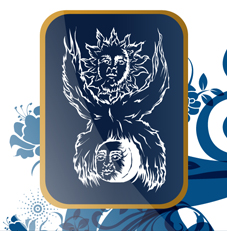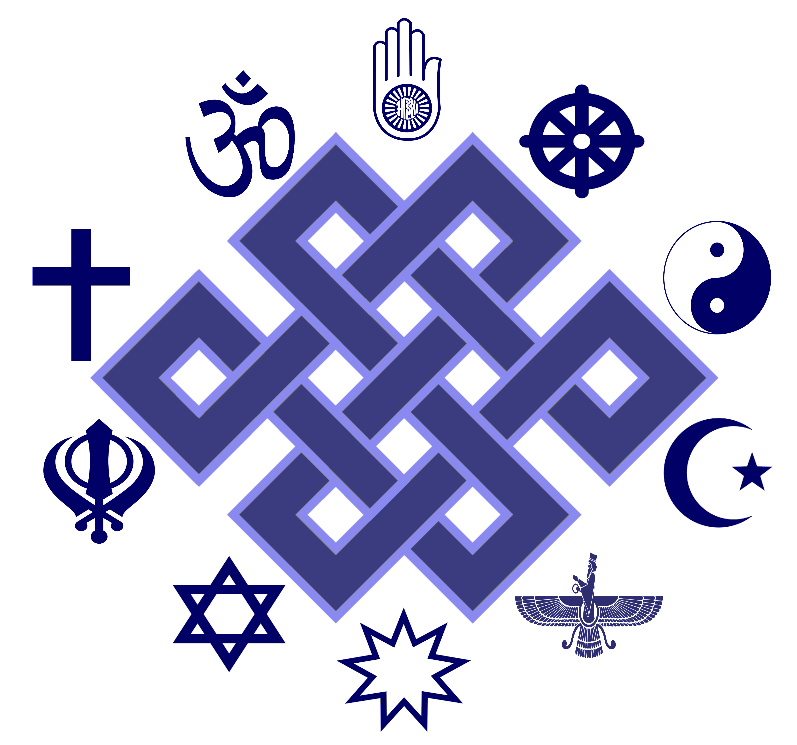







|
The Moon in Religious Festivals[1] © Malvin Artley 2014 The following table gives some of the major religious celebrations according to the position of the moon when it is in the sign listed in the first column on the left. There are many others, but the ones listed are most of the major ones for each of the religions listed. This is not intended as an exhaustive listing, but is more to connect the religions with the lunar phases and thus the luni-solar interaction. For a more complete listing of all the religious festivals, whether calculated according to the moon or not, see the individual months for religious festivals on these web pages. For columns where there are few entries, such as is the case with Christianity, it is an indication that the religion does not generally use the moon as a marker for its festivals. Christianity and Islam are of interest in that regard, and the Christian world has adopted a solar calendar, which is further of interest with regard to the differences in approach to spirituality between East and West. Judaism, Hinduism and Taoism rely heavily on the soli-lunar relation for determination of their spiritual festivals, whereas the West does not, except for Easter, nor the Middle East on the whole, except for Ramadan, and with the exception of Israel. See also the notes after the table.
Notes: · In the first column to the left, there is a denomination of ‘Solar Terms’, which is of Chinese derivation. It describes the twenty-four divisions of the solar year in the Chinese calendar, which interact precisely (more or less) with the signs of the Western zodiac. They are listed by number, and each Western sign encompasses two of them, starting with the Li Chun, which takes place about February 4 each year. In the column they are listed as whole numbers or as X.5, ‘X’ being the number of the Branch of the solar term, the .5 meaning the solar term takes place halfway through the Branch. There are twelve Branches, or Chinese solar months, starting with Li Chun. · The Islamic calendar, though it is a predominately lunar calendar, and due to it being either 354 or 355 days in length, retrogresses with regard to the solar calendar currently in world-wide use. Thus, each Muslim holiday falls progressively earlier in the solar year. Therefore, the dates listed in the table are only for the year 2012 and will change in forthcoming years in relation to the other religious holidays.[2] · The religions listed are the major religions according to the number of adherents, and in order from left to right. · Entries in italics are names of the months in the various systems. (FM)=full moon. (NM)=new moon. Further entries in parentheses are the days of the lunar months. The full moon generally falls on the 14th or 15th day of the lunar month. A Brief Explanation of the various religious holidays/festivals: What follows are brief descriptions of the various festivals listed in the preceding table, and in the order they appear in that table. Christian: Easter: There are many Christian holidays, but the only one mentioned in the table of this appendix is Easter. This is due to the fact that this is the only Christian holiday that is reckoned according to the moon. Even then, Easter does not usually fall exactly on the day of the full moon, but is rather placed as the first Sunday after the ecclesiastical full moon (which can differ from the date of the actual full moon by as much as two days), just after the northern vernal equinox. From what has been put forward about the full moon festivals, however, Easter as the main Christian holy day fits with the constructs of esoteric astrology. Feast of the Virgin: This is largely only celebrated in Italy, but it honors the Virgin Mary, who is said to have appeared in the village of Carmine in 1251.[3] Islam: Laylat al-Bara’at: The night of records and the night of deliverance. A festive nightlong vigil with prayers, and in some regions also a night where deceased ancestors are commemorated. . Ramadan Commences at the new moon of Cancer or the first new moon after the northern summer solstice. One of the five pillars of Islam and a month of fasting. Eid al-Fitr: End of Ramadan and fasting. Aid El Adha: The celebration concluding the Hajj (pilgrimage to Mecca). Muharram (Islamic New Year): Usually a day of quiet observances. Day of Ashura: A Shia holiday and national holiday in many Islamic countries, the day of mourning for the grandson of Muhammad who died at the Battle of Karbala. In Sunni Islam, it is a day of fasting, commemorating the fast of Moses, which was for the deliverance of the people of Israel at Medina, according to some sources. In Judaism this corresponds to Yom Kippur, although it is in a different month, and which is the day of atonement in the Jewish calendar. This is typically a day of violence in the Islamic world, and the manner of its celebration and what it stands for in the Islamic traditions highlights the schism between the Shia and Sunni communities. It is celebrated in Islam in a different month from Yom Kippur to differentiate the Islamic holy day from the Jewish holy day. 12 Rabi al-Awal: Birth of Mohammad. Hinduism:[4] Caitra: The month of the creation of the universe. Hindu New Year. Ram Nayami: Birth of Lord Rama. The nine days leading up to this day are marked by continuous recitation, ending with pujas and aarti.[5] Hanuman Jayanti: Birth of the god Hanuman, worshipped for his unflinching devotion to Rama. Baisakhi (Vaisakha), or Buddha Purnima: Birth of Guatama, the Buddha. Vat Purnima: A day when women pray for their husbands and celebrated by tying cords around banyan trees. It honors Savitri, who enabled her husband to escape from the hands of Yama, Lord of Death. Snana Yatra: A bathing festival, wherein deities important to the Jagannath Cult are ritually bathed and decorated for public audience. Guru Purnima: A day marking veneration for the guru (a day for all gurus). Krishna Janmashtami: Celebrated by dramatic enactments of the life of Krishna. Raksha Bandhan: The festival of brothers and sisters. Commemorated by the symbolic tying of rakhi (sacred threads) around the wrist of a brother by his sister, thus symbolizing her love and prayers for her brother’s well-being and his lifelong vow to protect her. Today Hindu girls tie rakhi on the wrists of youths they consider to be their brothers. Anant Chaturdashi: A Jain celebration for the god Vishnu, considered to be especially auspicious if the day falls on the full moon. For acquiring of lost opulence. Kali Puja: The festival of Kali, the goddess of empowerment, of time and change. Kali was originally the annihilator of evil influence. She is worshipped as the ultimate reality, and she is foremost amongst the ten fierce tantric goddesses. Durga Puja (6th–10th days): Durga is another of the fierce Hindu goddesses and she is particularly known for defeating Mahishasura, the buffalo demon. This is one of the biggest annual festivals in Hinduism, and is sometimes known as Dashain. Dasehra (also known as Navratri, another of the festivals celebrating Durga): This is a very important and major festival in western and northern India. Sharad Purnima [Lakshmi festival]: This is the most important of the Durga festivals and is a celebration of the goddess Lakshmi. It is observed by a night vigil, and is a traditional celebration of the moon, also marking the end of the monsoon. Lakshmi is the consort of Vishnu and is the goddess of good luck and protectress of devotees against sorrows and financial straits. Divali/Festival of Lights: A national holiday in India. Celebrated by the lighting of small clay lamps filled with oil to signify the triumph of good over evil. This is celebrated over four days, starting on 29th Āśvina. Kartik Purnima: The festival of lights of the gods, celebrated for the killing of the demon, Tripurasura. Dedicated to the pitris. This is also known as a day of illuminations. Kālabhairava Jayanti: Kālabhairava is a fierce manifestation of Shiva, and special prayers and rituals are said and performed on this day. Vaikuntha Ekadashi: A day of fasting, when the ‘gate to the Lord’s inner sanctum’ is opened. Especially important to Vishnu adherents, special prayers, yajnas (a fire ritual of offerings), discourses and speeches are arranged at Vishnu temples on this day. Vesant Panchami: The Festival of Kites, dedicated to the goddess Saraswati. This marks the start of spring and the Holi season. Saraswati is the goddess of knowledge, music, art and culture. Ratha Saptami: Dedicated to the god, Surya, the Sun. It marks the time ‘when the sun turns northward’. It is the Sun-god’s birthday. Holi: The Festival of Colors. A celebration of the new season and the passage of the old year. Celebrations include the lighting of a bonfire, during which people throw colored powder at each other in celebration of the colors of spring. It is also a celebration of the burning of the demoness, Holika, sister of the great demon king Hiranyakashipu. Buddhism:[6] Pilgrim Festival: Celebration of the birth of Shakyamuni and an important day for pilgrims. Wesak/Saka Dawa: The full moon of Taurus, but also celebrated by Tibetan Buddhists in June in leap years. The festival of the birth, death and enlightenment of Buddha Shakyamuni. Celebrated with an outdoor opera in Tibet and the release of captured animals. Festival of Hanging of the Thangka: Held at Tashilhunpo Monastery in Shigatse, Tibet. Incense Festival: Celebrated in Tibet. People dress up and party to drive away malevolent spirits. Sho Dun Festival [Yogurt Festival] (15th–24th days): Picnics and operas are held in parks in Tibet, especially at Norbulingka Monastery. There are often bonfires at night. Dharma Day: First turning of the wheel. A feast day in commemoration of Buddha’s first sermon. Pilgrims climb holy mountains. Asalha Puja: Dharma Day in Theravadin Buddhism, a celebration of the first turning of the wheel, wherein the Four Noble Truths were expounded. The first monastic order in Buddhism was established on that day. Buddha’s Joyful Day: Coinciding with the Hungry Ghost Festival (FM). The day when Buddha’s disciples emerged from the forests and reported on the results of their meditations. Because so many disciples had attained enlightenment in that period originally, the Buddha was very pleased. This took place in the 8th Month Madhu Purnima/Honey Full Moon: Commemorates an occasion when the Buddha retreated into the forest to bring peace between two quarrelling factions of disciples. According to legend, a monkey and an elephant fed him during that time (see figure in Appendix 7 for symbolic connections with meditative practices), the elephant bringing fruit, and the monkey bringing honeycomb. The monkey was so excited that the Buddha accepted his gift that he began leaping from tree to tree and fell to his death. Because of his generosity, the monkey was immediately reborn in the 2nd Heaven.[7] This is celebrated as a day of unity and harmony. In India and Bangladesh it is observed by bringing gifts of fruit and honey to the monasteries. Pavarana: [Marks the end of Vassa, ‘Buddhist lent’ in Theravadin Buddhism.] A day when all monks must come before the assembled sangha and atone for any offense committed during the Vassa period. Pavarana is not generally observed in Mahayana cultures. Buddha’s descent from heaven after preaching to his mother: All monasteries are opened and pilgrims gather. Losar: Tibetan New Year. Monlam Prayer Festival: The Great Prayer Festival in Tibetan Buddhism, begun by Tsongkhapa. This is the period of examinations for the Lharampa Geshe degree (the highest scholastic achievement in the Gelugpa tradition). It is the greatest religious festival in Tibet and before the crackdown by Chinese authorities, thousands of monks from the three major monasteries gathered for chanting prayers and performing religious rituals at Jokhang Temple in Lhasa. It is now most widely practiced by the Tibetan community in exile in India. Lantern Festival: Commemoration of the Buddha’s miracle at Sravasti. This is largely a Theravadin celebration. The full moon in Mahayana communities this month is dedicated to the culmination of Monlam festival, with elaborate pujas. Magha Puja: [Day of merit.] A Theravadin celebration, this is a day when Buddhists tend to go to temples to perform merit-producing activities. It is a day for veneration of the Buddha and his teachings. In all of Buddhism, it is a day especially commemorating the deity Chenrezig, or Avalokiteshvara. Festival to drive out evil spirits (28th–29th days): Lamas encircle Lhasa and blow trumpets to drive out evil spirits and expel the scapegoat. Taoism:[8] The Mysterious Lady of the Ninth Heaven [Chiu tien xuan nu]: She is said to catalog the nine Celestial Domains, direct the registers of human destiny and assemble the lists of the gods. One of the patrons of the divinational arts. Birthday of Immortal Lu tung-pin, patriarch of Internal Alchemy. (14th day, or FM): He is the deliverer of humanity from illusion and suffering. Dragon Boat Festival [also known as “Double Fifth”]: A feast day and celebration of Chu Yuan—sage, poet and patriot of the Spring and Autumn period, remembered by the Dragon Boat races. The Great Pure One: The second of the emanations of Lao Tzu, and ruler of the realm of Tai Chi—the Great Ultimate. Ghost Festival or All Souls Day: The day for honoring ancestors and for relieving the sufferings of the dead. A day when the lines of communication between the three realms—heaven, earth and hell—are more open than at other times. Rituals of honoring and healing are more powerful. Also known as Hungry Ghost Day. Offerings of food are made and paper items are burned to appease ancestors who have not been properly honored. Mid-Autumn Festival: Second only to Chinese New Year in its importance. This is the festival of the moon, a harvest festival, and it is a major family day, when the moon appears at its largest in the sky (‘harvest moon’). Double Ninth Day: Nine is considered the quintessential yang number, and this is considered a potentially dangerous day due to the double yang influence (9th month, 9th day). It is customary to go hiking in the mountains, enjoy the clarity of the heights and the autumn sky (in the Northern Hemisphere). A celebration of Tou-mu, the mother of the ‘Bushel of Stars’[9] and patron of inner alchemy, successful negotiation of this day is said to confer longevity. Celebration of Fu Hsi, patron of all forms of divination. 11th day: A celebration of the Celestial Lord Tai-i [also known as Chinese Halloween], who is said to have transmitted the Ghost Festival to humanity. Kitchen Lord: The offering of sacrifices to the Taoist Kitchen God. The Kitchen God records the deeds of the family, good and bad, and at the end of the year he ascends to heaven to give his report to the Jade Emperor. Typically, the ‘sacrifice’ is a sticky sweet lotus root cake, both to please the Kitchen God and hopefully to keep his mouth closed so he cannot disclose the less savory deeds of the family. New Year: The spring festival and ‘Jade Pure One’ [Tianguan]: A celebration of one of the emanations of Lao Tzu. Festival of Lanterns: Marks the last day of lunar New Year celebrations. For celebrating and cultivating positive relations between people, families, nature and the heaven realms. At night children go out to the temples carrying paper lanterns on which they solve riddles. Grand Pure One: One of the emanations of Lao Tzu, who rules the realm of Pa Kua—the realm of the eight trigrams of the I-ching, the fundamental principles of reality. Jewish:[10] Passover: Commemoration of the delivery of the Jewish people from their slavery in Egypt. Pesach Sheni: Second Passover. Lag B’Omer: Celebration of the life of Shimon bar Yochai, revealer of the deepest truths of the Zohar. Shavuot: Festival of Weeks—commemoration of the day God gave the Torah to the entire nation of the Jewish people at Mt. Sinai. The reaping of the spring wheat harvest. One of the three biblical pilgrimage holidays. Seventeenth of Tammuz: A fasting day, commemorating the breaching of the walls of the 2nd Temple in Jerusalem. Tisha B’Av: Commemoration of the destruction of the 1st and 2nd Temples in Jerusalem. Tu B’Av: A holiday of love, very favorable for weddings, similar to Valentine’s Day. Rosh Hashana: Jewish New Year, one of the high holy days. The anniversary of the day of creation. The day when God reviews the actions of the preceding year and decides the fate for the one commencing. Yom Kippur: The day of atonement and repentance, and the holiest of the days in the Hebrew year. Sukkot: One of the three Biblical holidays, mandating a pilgrimage to the Temple in Jerusalem. A remembrance that God provided for the needs of the Jews during their 40-year sojourn in the desert. Shemeni Atzeret: The 8th Day of Assembly. A biblically mandated holiday. No labor is performed on this day. A day of fire offerings. Simchat Torah: ‘Rejoicing with the Torah.’ Marks the end of the cycle of public Torah readings. This is celebrated in concert with Shemeni Atzeret. Hanukkah: Festival of Lights, or Feast of Dedication, commemorating the dedication of the 2nd Temple in Jerusalem. Tenth of Tevet: Commemorates the siege of Jerusalem by Nebuchadnezzar II of Babylonia—an event that began on that date and ultimately culminated in the destruction of Solomon’s Temple (the First Temple) and the conquest of the Kingdom of Judah. Tu Bishvat: ‘New Year of the Trees’. Ecological awareness day in Israel. Originally a feast day of fruits from the ten types of fruit trees of Israel. It is symbolic for one’s ever having to continue to grow in the knowledge of Torah, service of God and relationship to humanity. “Man is compared to the trees of the field.” Purim: Commemoration of the deliverance Jewish people in the ancient Persian Empire with the help of Xerxes of Iran. This is generally celebrated now as the day when “God wears a mask,” when life is seen as a masquerade, when the truth of things seems hidden. It marks abandonment of the illusion that one controls or even understands the world. Purim, along with Hanukkah, are the two holidays that are said will last forever, all the others eventually to fall away. [1] Taken directly from the Full Moons: Topical Letters in Esoteric Astrology, Appendix 11, Malvin Artley, 2014. See: www.malvinartley.com/news_west.htm [4] Source material from http://en.wikipedia.org/wiki/Hindu_holidays. [5] A religious ritual in pujas wherein lights from wicks soaked in camphor or ghee are offered to deities. Aarthi are also songs sung to the deities when the lamps are offered. [6] Source material from http://en.wikipedia.org/wiki/Buddhist_holidays. [7] Trāyastri: the highest of the heavens connected with this world. Its inhabitants are tied to this world. It is a realm of the demigods, the highest of the samsaric realms—atma. See: A Treatise on Cosmic Fire, p. 1083 footnote to “The Turning of the Wheel”. A life in the second heaven is said to last for 36 million years. https://en.wikipedia.org/wiki/Trāyastriṃśa [8] Referenced and verified from www.taoism.about.com/od/majorfestivals/a/festivals.htm , source material on the site supplied by Elizabeth Reninger, MA, MA in traditional Chinese medicine (TCM), Boulder, CO, USA. [9] The ‘Bushel of Stars/ is another name for the ‘Great Wagon’ or Great Bear—Ursa Major. [10] A quick guide to the Jewish holidays can be found at: www.askmoses.com/en/list/99/Holidays.html The site is run by Chabad of California. Chabad is the largest Jewish religious organization in the world, a Hasidic movement. |
